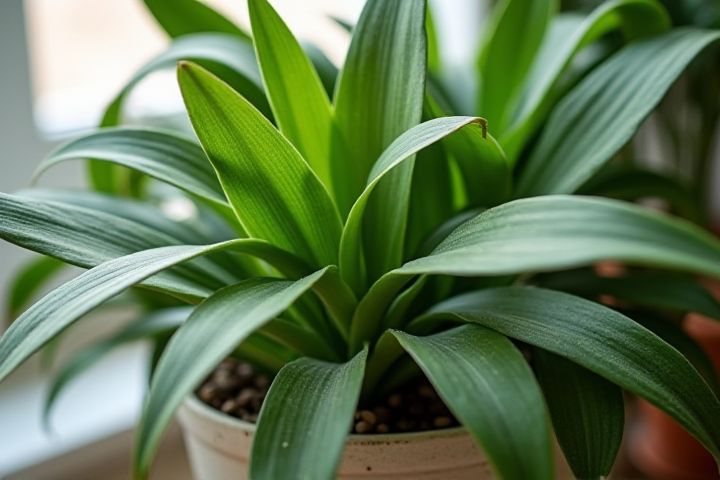
Arranging houseplants effectively enhances your interior decor while promoting healthy plant growth. Consider the lighting requirements of each plant; for instance, position succulents and cacti in bright, sunny spots, while placing ferns and peace lilies in shaded areas. Use varying heights and textures to create visual interest; taller plants like snake plants can be contrasted with trailing plants such as pothos. Group plants with similar water and humidity needs together, ensuring you maintain optimal care routines. Finally, utilize stylish pots and plant stands to enhance aesthetics, making sure each plant is easily accessible for maintenance.
How To Arrange Houseplants
Light requirements
Position houseplants according to their specific light requirements to ensure optimal growth. Low-light plants, such as snake plants and pothos, thrive in spaces with indirect sunlight, making corners or north-facing windows ideal. Bright, direct sunlight plants, like succulents and cacti, should be placed near south-facing windows where they can absorb the maximum light exposure for at least six hours a day. For those in between, medium light plants like peace lilies can benefit from east or west-facing windows, allowing for a balanced light regimen.
Plant size
Position larger houseplants, such as Ficus or Monstera, in corners or behind furniture to create visual balance while maximizing space. Medium-sized plants, like Snake plants or ZZ plants, work well on shelves or tabletops, enhancing upward growth and adding greenery at eye level. Smaller plants, such as succulents or air plants, can be clustered on windowsills or coffee tables, allowing for easy care and maintenance. Remember, varying plant heights not only improves aesthetics but also ensures that each plant receives adequate light, contributing to overall health and vitality.
Grouping by humidity needs
Grouping houseplants by humidity needs is essential for creating a thriving indoor garden. Tropical plants, such as peace lilies and ferns, prefer higher humidity levels (around 60-80%) and should be placed together in a humid environment or near a pebble tray filled with water. In contrast, succulents and cacti thrive in lower humidity (about 30-50%) and should be kept in drier areas with good air circulation. By arranging your plants based on their humidity requirements, you can ensure optimal growth and reduce maintenance challenges, leading to a more vibrant and healthy collection.
Companion planting
Companion planting with houseplants can enhance growth and create a thriving indoor ecosystem. For optimal results, place aromatic plants like basil or mint near thriving companions like tomatoes or peppers, as their scents repel pests and encourage pollination. Group plants with similar light and humidity needs together; for instance, pairing peace lilies with spider plants promotes effective moisture levels. Remember, strategic placement not only maximizes space but also enhances the aesthetic appeal of your living environment.
Varied heights
Arranging houseplants at varied heights creates visual interest and a dynamic indoor landscape. Utilize plant stands, shelves, or hanging planters to elevate smaller plants, ensuring taller varieties like fiddle leaf figs or snake plants stand out. Consider grouping plants in clusters, with shorter plants like pothos or ferns at the front and taller species at the back, maintaining balance and harmony. For optimal growth, ensure each plant receives adequate light according to its height and specific needs.
Rotating plants regularly
Rotating houseplants regularly promotes even growth by ensuring all parts of the plant receive adequate sunlight exposure, preventing one side from becoming leggy while the other thrives. When arranging your plants, place taller varieties towards the back to maximize light reaching smaller species, creating a visually appealing display. Periodically turning your plants helps them develop a more balanced and bushy shape, enhancing their overall health. To maintain a vibrant indoor garden, consider setting a reminder to rotate your plants every few weeks, tailored to their individual light requirements.
Drainage considerations
When arranging houseplants, prioritize drainage to ensure optimal health and growth. Use pots with drainage holes to prevent water accumulation, which can lead to root rot. Elevating pots with a few small stones or a mesh layer at the bottom can enhance drainage and promote air circulation. Regularly check the soil moisture and select appropriate potting mixes that retain some moisture while allowing excess water to escape effectively.
Room temperature
When arranging houseplants, consider the specific room temperature requirements of each species to ensure optimal growth. Tropical plants, for instance, thrive in warmer environments, typically between 65degF to 80degF, making them perfect for living rooms or sunrooms. In contrast, succulents and cacti prefer cooler conditions, ideally around 60degF to 70degF, so position them in areas with good airflow and indirect sunlight. By tailoring the placement of your plants based on their temperature preferences, you enhance their health and aesthetic appeal in your home.
Aesthetic coherence
Positioning houseplants for aesthetic coherence involves considering factors such as color, texture, and scale. Group plants with similar foliage colors, like deep greens or variegated leaves, to create a unified visual experience. Strategically place taller plants, such as fiddle leaf figs, alongside cascading varieties like pothos to enhance dimensions and balance. Incorporate decorative pots that complement your interior design style, whether it's minimalistic, bohemian, or traditional, to further unify the overall look of your space.
Accessibility for care
To arrange houseplants with accessibility in mind, place low-maintenance varieties, such as pothos and snake plants, within easy reach on tables or shelves. Utilize plant stands or hanging planters to elevate plants, ensuring that watering and pruning tasks are convenient and not cumbersome. Keep frequently used tools, like watering cans and pruning shears, in close proximity to your plants to streamline care. Remember to cluster plants with similar light and watering needs together to simplify the care routine and enhance their overall health.
